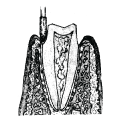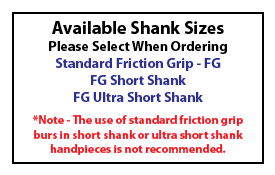Lasco RGC Diamond Burs
Rotary Gingival Curettage

RGC Diamond Burs are available as individuals insturments or sold in sets of 11 pieces each (Coarse RGC Set, Fine RGC Set, and Matching Square End RGC Set.
Special On-Line Price $5.95 each
Click on the tool picture to make your selections
Coarse Grit RGC Diamond Bur Set
Fine Grit RGC Diamond Burs
Matching Square End RGC Set (For Initial Cut)

Rotary Gingival Curettage - Technique Summary
This procedure was originally developed in the 1970’s by Dr. Rex Ingraham and his associates at the USC School of Dentistry. This technique is a method for handling the interfering tissue during restorative procedures. The technique eliminates the trauma of pressure packing or the necessity of electro-surgery around subgingival cavity preparations. A series of diamond instruments of special shape, grit, and quality control allows the crevicular epithelium to be precisely removed without tagging or tearing tissue at the same time a bevel finish line is completed. Increased impression material without constriction in the marginal areas allows greater accuracy and consistency of impressions. The advantages of this technique are its simplicity, successful, predictable tissue response, usable successful impressions, rapid healing and patient comfort.
Rotary Gingival Curettage instruments are specially designed and rigidly controlled in order to achieve efficient cutting of the tooth while eliminating any scoring grits in order to simultaneously achieve a smooth tissue result. This technique is contrary to that which has been traditionally advocated, however, rotary diamond abrasion of tissue has been employed for years in Periodontia.
When tissue is pressured-packed in the conventional manner, hemorrhage and rebound occurs upon the removal of the retraction cord. The tissue usually shrinks back to its original position and the free crest collapses or falls inward. This often clips or pinches the impression material resulting in torn and crumbled marginal impressions. Rotary Gingival Curettage, through a mild curetting action, releases the tension of the crevicular epithelium and gives the operator a sufficiently wide trough that holds a greater volume of impressions material in the marginal finish-line zone which strengthens the part of the impression. With no tension exerted by the epithelial tissue on the impression material, the tray can be removed with a perfect impression, eliminating the aggravation of torn margins and repeated impressions.
Initial hemorrhaging will subside to a mild seepage or oozing. Smooth curetting of the tissue allows the capillaries to initiate the healing process immediately. Gouging and tearing, through improper instrumentation results in excessive bleeding and retarded healing. Retraction cord is lightly placed (not packed) and kept moist to complete the hemostasis. Caution: The success of the technique is dependent on not pressure packing or dessicating the tissue prior to impression making.
Standard impression making can now be employed with surprising results to the dentist and the laboratory technician. The curved bevel margins and finish-lines are well demarcated by the shape of these diamonds. Further alterations of the finish line or shoulders are completed with conventional shapes.
Lasco Rotary Gingival Curettage Diamonds are available in both Coarse and Fine grits. The Coarse grit is recommended when gross tooth reduction is done in conjunction with Gingival Curettage. The Fine grit is recommended for doing Gingival Curettage exclusively.
The larger diamonds are recommended when the tissue is thick or heavy. The smaller ones are used for thin, frail tissue. The 10mm lengths are indicated for the long crowned teeth, for badly receded or deeply decayed cases. The 6mm lengths are for short crown, broken teeth and small mouths or difficult access. The 8mm lengths will handle most conditions.






